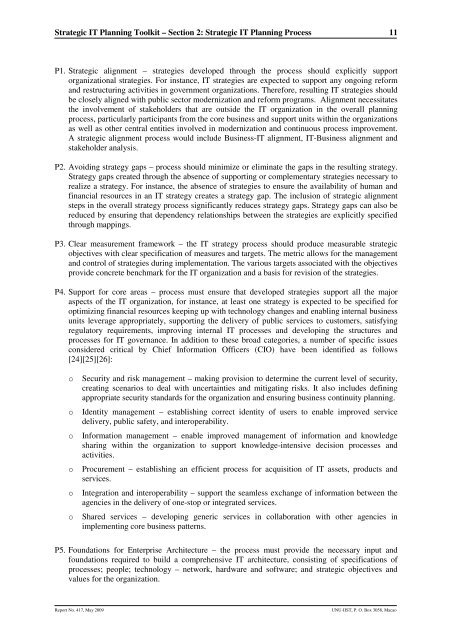Strategic IT Planning for Public Organizations: A Toolkit - UNU-IIST ...
Strategic IT Planning for Public Organizations: A Toolkit - UNU-IIST ...
Strategic IT Planning for Public Organizations: A Toolkit - UNU-IIST ...
You also want an ePaper? Increase the reach of your titles
YUMPU automatically turns print PDFs into web optimized ePapers that Google loves.
<strong>Strategic</strong> <strong>IT</strong> <strong>Planning</strong> <strong>Toolkit</strong> – Section 2: <strong>Strategic</strong> <strong>IT</strong> <strong>Planning</strong> Process<br />
11<br />
P1. <strong>Strategic</strong> alignment – strategies developed through the process should explicitly support<br />
organizational strategies. For instance, <strong>IT</strong> strategies are expected to support any ongoing re<strong>for</strong>m<br />
and restructuring activities in government organizations. There<strong>for</strong>e, resulting <strong>IT</strong> strategies should<br />
be closely aligned with public sector modernization and re<strong>for</strong>m programs. Alignment necessitates<br />
the involvement of stakeholders that are outside the <strong>IT</strong> organization in the overall planning<br />
process, particularly participants from the core business and support units within the organizations<br />
as well as other central entities involved in modernization and continuous process improvement.<br />
A strategic alignment process would include Business-<strong>IT</strong> alignment, <strong>IT</strong>-Business alignment and<br />
stakeholder analysis.<br />
P2. Avoiding strategy gaps – process should minimize or eliminate the gaps in the resulting strategy.<br />
Strategy gaps created through the absence of supporting or complementary strategies necessary to<br />
realize a strategy. For instance, the absence of strategies to ensure the availability of human and<br />
financial resources in an <strong>IT</strong> strategy creates a strategy gap. The inclusion of strategic alignment<br />
steps in the overall strategy process significantly reduces strategy gaps. Strategy gaps can also be<br />
reduced by ensuring that dependency relationships between the strategies are explicitly specified<br />
through mappings.<br />
P3. Clear measurement framework – the <strong>IT</strong> strategy process should produce measurable strategic<br />
objectives with clear specification of measures and targets. The metric allows <strong>for</strong> the management<br />
and control of strategies during implementation. The various targets associated with the objectives<br />
provide concrete benchmark <strong>for</strong> the <strong>IT</strong> organization and a basis <strong>for</strong> revision of the strategies.<br />
P4. Support <strong>for</strong> core areas – process must ensure that developed strategies support all the major<br />
aspects of the <strong>IT</strong> organization, <strong>for</strong> instance, at least one strategy is expected to be specified <strong>for</strong><br />
optimizing financial resources keeping up with technology changes and enabling internal business<br />
units leverage appropriately, supporting the delivery of public services to customers, satisfying<br />
regulatory requirements, improving internal <strong>IT</strong> processes and developing the structures and<br />
processes <strong>for</strong> <strong>IT</strong> governance. In addition to these broad categories, a number of specific issues<br />
considered critical by Chief In<strong>for</strong>mation Officers (CIO) have been identified as follows<br />
[24][25][26]:<br />
o Security and risk management – making provision to determine the current level of security,<br />
creating scenarios to deal with uncertainties and mitigating risks. It also includes defining<br />
appropriate security standards <strong>for</strong> the organization and ensuring business continuity planning.<br />
o Identity management – establishing correct identity of users to enable improved service<br />
delivery, public safety, and interoperability.<br />
o In<strong>for</strong>mation management – enable improved management of in<strong>for</strong>mation and knowledge<br />
sharing within the organization to support knowledge-intensive decision processes and<br />
activities.<br />
o Procurement – establishing an efficient process <strong>for</strong> acquisition of <strong>IT</strong> assets, products and<br />
services.<br />
o Integration and interoperability – support the seamless exchange of in<strong>for</strong>mation between the<br />
agencies in the delivery of one-stop or integrated services.<br />
o Shared services – developing generic services in collaboration with other agencies in<br />
implementing core business patterns.<br />
P5. Foundations <strong>for</strong> Enterprise Architecture – the process must provide the necessary input and<br />
foundations required to build a comprehensive <strong>IT</strong> architecture, consisting of specifications of<br />
processes; people; technology – network, hardware and software; and strategic objectives and<br />
values <strong>for</strong> the organization.<br />
Report No. 417, May 2009<br />
<strong>UNU</strong>-<strong>IIST</strong>, P. O. Box 3058, Macao

















